In the world of facial aesthetics, few features have captivated human imagination as deeply as the Greek nose. Known for its straight, elegant bridge and harmonious balance, this nose shape has been celebrated for centuries as the epitome of classical beauty. From ancient Greek sculptures to modern cosmetic standards, the Greek nose represents symmetry, proportion, and refinement, qualities that define timeless attractiveness.
 In this comprehensive guide, we’ll explore what makes the Greek nose unique, why it has been admired for millennia, how it relates to facial harmony, and what modern aesthetic medicine can do to achieve or enhance this sought-after feature.
In this comprehensive guide, we’ll explore what makes the Greek nose unique, why it has been admired for millennia, how it relates to facial harmony, and what modern aesthetic medicine can do to achieve or enhance this sought-after feature.
Greek Nose Shape
A Greek nose, also known as a straight nose or classic nose, is characterized by a perfectly straight nasal bridge that extends in a smooth line from the forehead to the tip without any curvature or indentation.
Key Features
- Straight dorsum: The bridge of the nose appears linear and even.
- No dorsal hump: Unlike other nose types (e.g., Roman or Aquiline), the Greek nose lacks a prominent bump.
- Balanced nasal tip: The tip is usually defined but not overly lifted or drooping.
- Proportional width: The nose width complements facial proportions, neither too wide nor too narrow.
This structure contributes to a clean, symmetrical facial profile, often associated with intelligence, confidence, and aesthetic harmony.
Greek Nose in Females
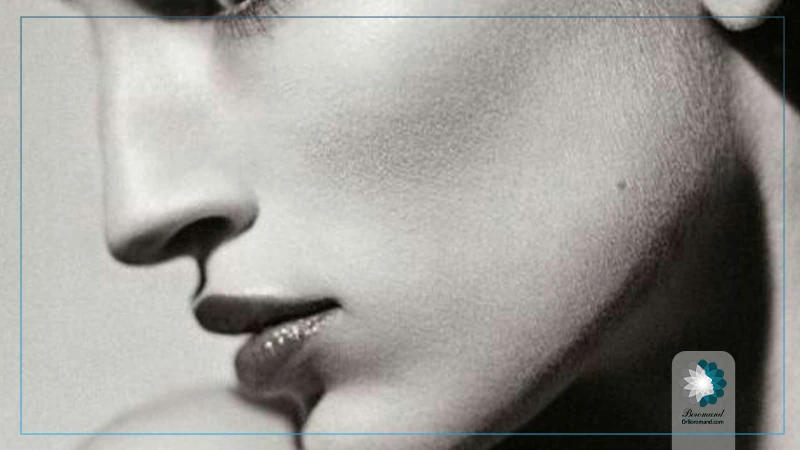 In women, the Greek nose is often admired for its refined and elegant straightness. It conveys balance and sophistication without appearing harsh. A straight bridge gives the face a clean, sculpted look, enhancing features like the eyes and cheekbones.
In women, the Greek nose is often admired for its refined and elegant straightness. It conveys balance and sophistication without appearing harsh. A straight bridge gives the face a clean, sculpted look, enhancing features like the eyes and cheekbones.
However, in female aesthetics, surgeons often soften the Greek profile slightly, adding a gentle curve or subtle tip lift to preserve femininity and approachability. A perfectly straight nose on a female face can appear powerful, but a slightly softened version often creates a more natural harmony.
Ideal candidates are those with oval or heart-shaped faces, where a straight nose complements delicate bone structure and accentuates facial symmetry.
Greek Nose in Males
For men, the Greek nose represents strength, confidence, and classical masculinity. Its straight line from the forehead to the tip gives the profile a firm, structured look often associated with leadership and character.
Unlike in female aesthetics, a completely straight or slightly stronger bridge is desirable in men as it emphasizes jawline definition and balances facial proportions. This type of nose works particularly well on men with angular or rectangular faces, enhancing their overall symmetry without appearing overly sharp or dramatic.
The Greek nose also projects a timeless, noble look, reminiscent of ancient sculptures of heroes and gods like Apollo and Zeus.
Greek Nose: Female vs. Male
While both genders share the same straight nasal bridge, the subtle differences in angle, proportion, and tip definition define the masculine or feminine result.
| Feature | Female Greek Nose | Male Greek Nose |
| Bridge Shape | Straight or slightly softened | Straight and firm |
| Tip Angle | Slightly upturned (95–105°) | Neutral or slightly downward (90–95°) |
| Aesthetic Effect | Graceful, refined, balanced | Strong, structured, confident |
| Preferred Adjustments | Softer lines, smaller projection | Sharper bridge, defined base |
In short, the Greek nose adapts beautifully to both male and female faces — it’s the proportions and subtle sculpting that make the difference between elegance and strength.
The Historical and Cultural Roots of the Greek Nose
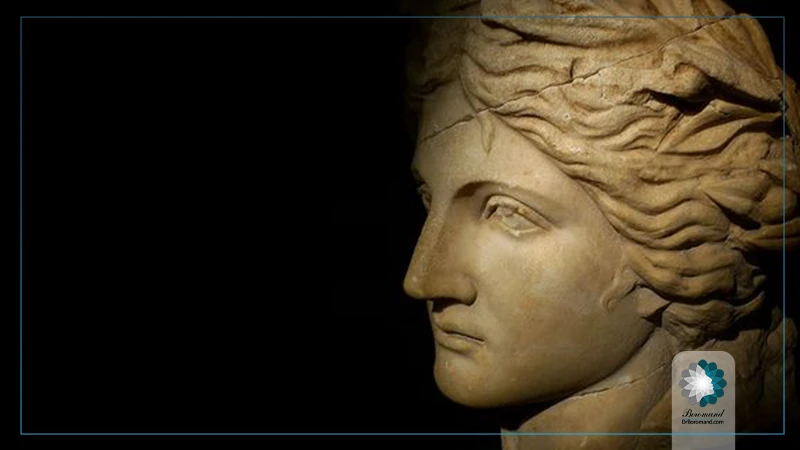 Classical Origins
Classical Origins
The term “Greek nose” dates back to ancient Greece, where artists and sculptors like Phidias and Polykleitos depicted gods, athletes, and philosophers with straight, well-proportioned noses. In their art, the human form was idealized based on mathematical ratios and golden proportions, and the straight nose was a hallmark of perfection.
Symbolism in Ancient Art
In Greek culture, physical symmetry was considered a reflection of inner balance and virtue. The straight, noble nose became a symbol of moral integrity, intellect, and strength. That’s why many famous statues — such as those of Apollo, Aphrodite, and Zeus, exhibit this distinctive nasal form.
Influence on Western Beauty Standards
As classical art spread through Europe during the Renaissance, the Greek ideal of beauty continued to influence sculpture, portraiture, and later, cosmetic aesthetics. The Greek nose came to represent refined taste, purity, and noble lineage, setting the standard for what was considered beautiful for centuries.
The Greek Nose in Modern Aesthetic Standards
A Timeless Ideal
Even in today’s era of diverse beauty trends, the Greek nose remains one of the most desired shapes in cosmetic and surgical aesthetics. Its clean lines and symmetrical contour fit seamlessly into many facial structures, making it a versatile and universally admired feature.
The Role of Proportion
Facial harmony is not about a single “perfect” feature, it’s about balance. The Greek nose works well when the nasal length, bridge height, and tip projection align proportionally with the eyes, lips, and chin. This balanced geometry explains why many surgeons use the Greek nose as a reference model during facial analysis or rhinoplasty planning.
Greek Nose vs. Roman Nose
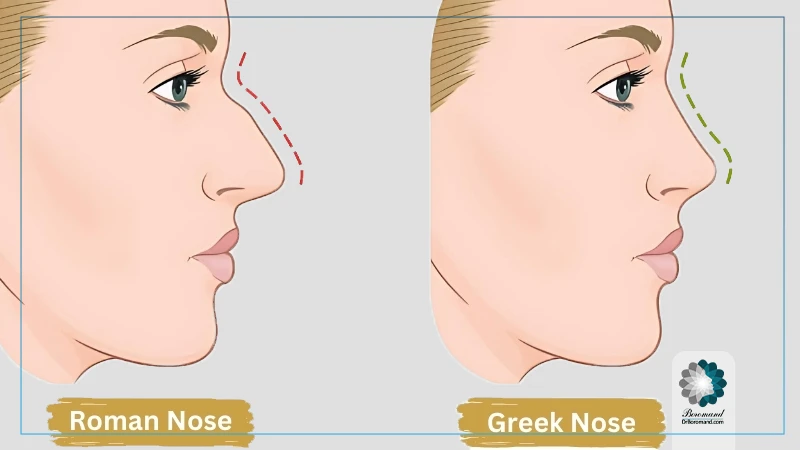 The Greek nose and the Roman nose are two of the most recognized nasal profiles in art, history, and modern aesthetics, both admired for different reasons, yet representing contrasting ideals of beauty and character.
The Greek nose and the Roman nose are two of the most recognized nasal profiles in art, history, and modern aesthetics, both admired for different reasons, yet representing contrasting ideals of beauty and character.
Also read: All about Roman Noses (aquiline noses)
Shape and Structure
The Greek nose is defined by its perfectly straight bridge, forming a smooth line from the forehead to the nasal tip. It represents balance, calm, and symmetry, qualities often associated with classical beauty.
In contrast, the Roman nose (also called the Aquiline nose) features a prominent bridge or slight curve that may project outward before descending toward the tip. This creates a stronger, more assertive profile, historically linked to leadership and determination.
Aesthetic Impression
- Greek Nose: Smooth, refined, and harmonious; ideal for a clean and timeless facial balance.
- Roman Nose: Bold, powerful, and dramatic; conveys strength and confidence.
Surgical and Artistic Perspectives
In modern rhinoplasty, some patients request a Greek-style refinement to soften the Roman curve, while others choose to retain or accentuate the Roman bridge as part of their distinctive identity.
Both forms are considered beautiful — the Greek nose for its symmetry and serenity, the Roman for its character and individuality. The key is not which one is better, but which best expresses a person’s natural proportions and personality.
Nubian Nose vs. Greek Nose
The Nubian nose and the Greek nose represent two distinct yet equally beautiful expressions of human diversity in facial structure. Each carries its own aesthetic value, shaped by culture, genetics, and individual character.
Shape and Structure
A Nubian nose is typically characterized by a longer bridge, wider nostrils, and a softer, rounded tip. It’s often associated with warmth and expressiveness, giving the face a friendly and open appearance.
The Greek nose, on the other hand, features a straight, narrow bridge with refined contours and a balanced tip. This shape is admired for its symmetry and classical elegance, symbolizing proportion and calm strength.
| Feature | Nubian Nose | Greek Nose |
| Bridge Shape | Longer and slightly curved | Straight and smooth from forehead to tip |
| Nostrils | Wider, rounded, and expressive | Narrower and more defined |
| Tip Shape | Soft and rounded | Balanced and gently pointed |
| Overall Look | Natural, warm, and expressive | Structured, refined, and harmonious |
| Cultural Symbolism | Associated with authenticity, emotion, and individuality | Linked to symmetry, balance, and classical beauty |
| Ideal Face Match | Complements fuller or heart-shaped faces | Complements oval or angular faces |
| Common Enhancements | Tip contouring or nostril narrowing | Smoothing the bridge or refining the tip |
Aesthetic Interpretation
While the Nubian nose highlights individuality and natural softness, the Greek nose emphasizes structure and harmony. Neither is superior, they simply reflect different kinds of beauty.
In modern aesthetic practice, the goal isn’t to change one into the other, but to enhance balance while celebrating each person’s unique heritage and natural form.
Common Comparisons: Greek Nose vs. Other Nose Types
| Nose Type | Description | Key Difference from Greek Nose |
| Roman Nose (Aquiline) | Has a pronounced bridge or small bump. | Greek nose is completely straight. |
| Snub Nose | Short, upturned tip. | Greek nose has a longer, straighter profile. |
| Nubian Nose | Wider nostrils and longer base. | Greek nose is narrower and more refined. |
| Button Nose | Small, rounded, and upturned. | Greek nose appears more linear and defined. |
Each shape can be beautiful in its own way — but the Greek nose stands out for its timeless symmetry and classical elegance.
Greek Nose and Facial Harmony
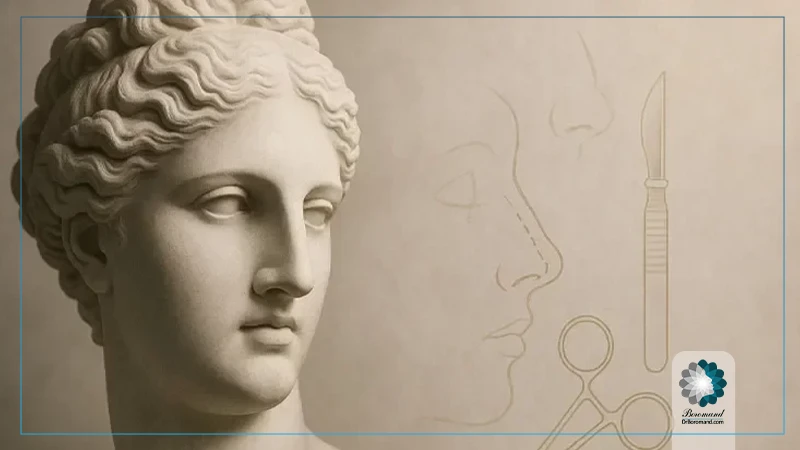 The beauty of the Greek nose lies in how it balances the facial features. In aesthetic medicine, it’s often associated with the “golden ratio” , a mathematical proportion found in nature, art, and the human face.
The beauty of the Greek nose lies in how it balances the facial features. In aesthetic medicine, it’s often associated with the “golden ratio” , a mathematical proportion found in nature, art, and the human face.
A straight nose with balanced projection tends to:
- Enhance cheekbone definition.
- Create a smooth transition from forehead to mouth.
- Give the face a calm, intelligent expression.
These characteristics make the Greek nose highly compatible with various ethnic and facial types, provided that it aligns with each individual’s unique facial structure.
Greek Nose Celebrities
Throughout history and modern entertainment, many well-known figures have been admired for having a Greek-style nose, a straight, harmonious bridge that enhances their overall facial balance. This classic nose shape appears across different eras, from ancient ideals to Hollywood icons, symbolizing both strength and elegance.
Famous Female Celebrities with a Greek Nose
- Natalie Portman – Known for her balanced, symmetrical face and straight nasal bridge that perfectly complements her delicate features.
- Jennifer Connelly – Her straight, structured nose gives her a refined and timeless look.
- Keira Knightley – The linear bridge and defined tip create a strong yet feminine appearance.
- Charlize Theron – Her profile shows the classic proportion of a Greek nose: straight, graceful, and naturally aligned.
Famous Male Celebrities with a Greek Nose
- Henry Cavill – His strong, straight nose enhances his chiseled, symmetrical facial structure.
- David Gandy – The smooth nasal line emphasizes masculine refinement and proportion.
- Christian Bale – Known for a well-defined, balanced profile that matches the classical Greek aesthetic.
- Tom Hiddleston – His straight nasal bridge gives an elegant, intelligent expression — key traits of the Greek ideal.
In both men and women, the Greek nose helps define a balanced, proportionate profile that photographs beautifully and appears effortlessly timeless. This is why many aesthetic specialists still use such celebrity profiles as reference examples when discussing ideal nasal proportions or rhinoplasty goals.
Greek Nose Side Profile, Front View, and Rounded Tip Variations
From the side profile, a Greek nose is easily recognizable by its perfectly straight bridge that creates a smooth, unbroken line from the forehead to the nasal tip, one of the most admired angles in classical and modern beauty alike.
When viewed from the front, the Greek nose appears symmetrical and narrow, with balanced nostrils and a refined central alignment that enhances the harmony of the entire face.
Some individuals naturally have a Greek nose with a rounded tip, where the bridge remains straight but the nasal tip is softly contoured. This variation adds a touch of warmth and approachability to the otherwise structured and elegant profile, a blend of classical precision and natural softness that many find ideal.
Can You Get (or Avoid) a Greek Nose? – Modern Treatments and Procedures
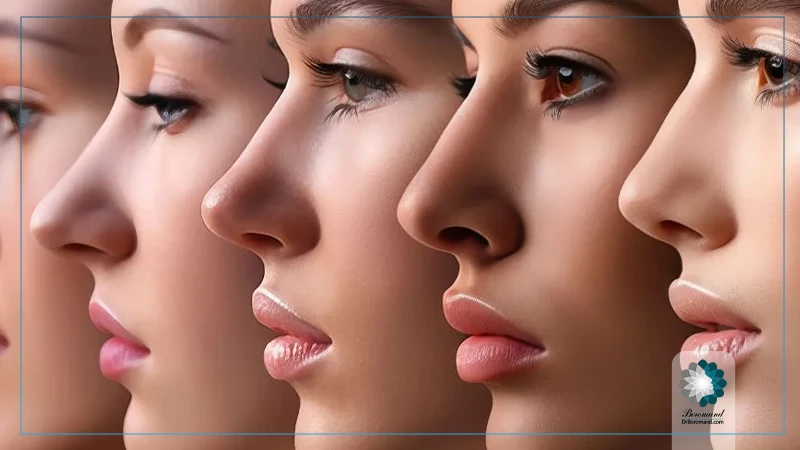 Modern aesthetic medicine offers several ways to achieve a Greek-style nose or, conversely, to soften its appearance if that straight classical profile isn’t your personal ideal. The goal is always harmony, not conformity to a single standard.
Modern aesthetic medicine offers several ways to achieve a Greek-style nose or, conversely, to soften its appearance if that straight classical profile isn’t your personal ideal. The goal is always harmony, not conformity to a single standard.
Achieving a Greek Nose
A rhinoplasty can refine the nasal bridge and tip to create the smooth, straight line that defines a Greek nose.
Common goals include:
- Removing a dorsal hump to make the bridge completely straight.
- Refining the nasal tip for balance and proportion.
- Aligning the nasal bridge with the forehead line for a seamless contour.
Choosing Not to Have a Greek Nose
While the Greek nose is widely admired, it’s not for everyone. Some people prefer a softer or more curved profile, especially if it feels more authentic to their ethnic background or facial personality.
Aesthetic specialists can intentionally preserve or even enhance natural bumps, gentle slopes, or subtle curves to maintain individuality.
Ultimately, the best outcome is not about having a Greek nose, it’s about having your nose, one that fits your features, your story, and your sense of self. Modern techniques make it possible to shape, refine, or protect that uniqueness with precision and respect for your natural beauty.
The Psychology of the Greek Nose
Beyond aesthetics, the Greek nose often evokes perceptions of strength, intelligence, and calm confidence. Studies in facial perception show that people subconsciously associate straight, symmetrical features with trustworthiness and leadership, qualities that align perfectly with this classical form.
However, beauty remains subjective. The goal of modern aesthetics is not to replicate a single “ideal,” but to enhance natural harmony, ensuring that every face retains its individuality and authenticity.
Choosing the Right Nose Shape for You
When considering rhinoplasty or facial balancing, the goal is not necessarily to achieve a Greek nose, but to find the shape that best fits your own proportions, ethnicity, and personality.
A qualified aesthetic specialist will assess:
- Your facial geometry and symmetry.
- Skin thickness and nasal structure.
- Your personal aesthetic goals.
The most beautiful result is one that looks natural, harmonious, and uniquely yours.
Final Thoughts
The Greek nose continues to inspire artists, surgeons, and patients alike as a timeless symbol of balance, harmony, and elegance. Whether naturally inherited or achieved through modern aesthetic techniques, it reflects the enduring human desire for symmetry and proportion, the very principles that define classical beauty.
Yet, it’s important to remember that beauty is ultimately personal and artistic. What one person sees as the perfect straight line, another might find too defined or prefer a softer curve. The Greek nose is beautiful, but so are many other shapes that express individuality, culture, and emotion.
In the end, beauty is not about perfection; it’s about balance, authenticity, and self-expression. The Greek nose simply reminds us that true elegance lies not in uniformity, but in the art of harmony, where science, symmetry, and personal taste come together beautifully.
Free Consultation with the Doctor
For more information and to discuss your condition,contact Dr. Boromand on WhatsApp.
Free consultation on WhatsApp






Related Articles
What Not to Do After Rhinoplasty
December 2, 2025Types of Noses: Understanding Shapes, Features, and ...
November 9, 2025How Long Does It Take for a ...
October 27, 2025Greek Nose: Meaning, Aesthetic Ideal, and Modern ...
October 4, 2025Why Is Iran the Best Country to ...
September 24, 2025How Long Should You Stay in Iran ...
September 14, 2025